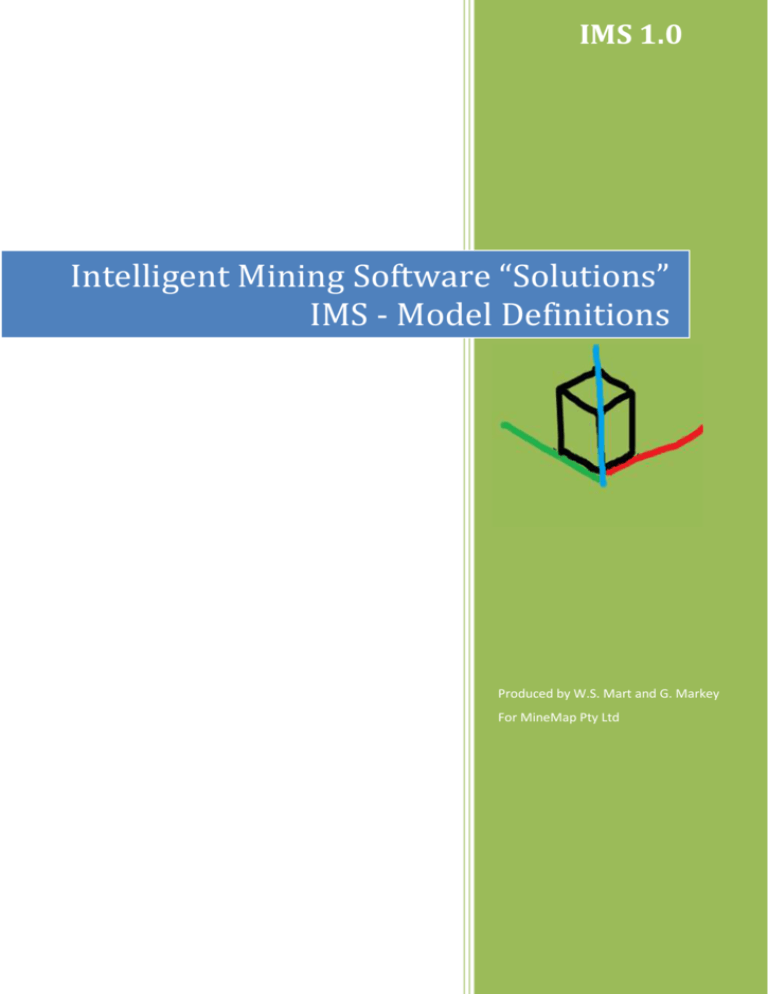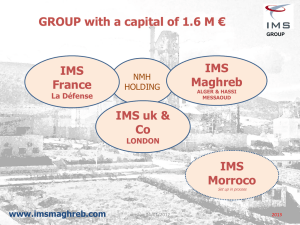
IMS 1.0
Intelligent Mining Software “Solutions”
IMS - Model Definitions
Produced by W.S. Mart and G. Markey
For MineMap Pty Ltd
Intelligent Mining Software “Solutions” IMS - Model Definitions
Copyright © 2013 by William Seldon Mart and Geoff Markey. All rights reserved.
Page 1
Intelligent Mining Software “Solutions” IMS - Model Definitions
Table of Contents
INTRODUCTION................................................................................................................................ 3
WORKING WITH A DEFINITION.................................................................................................. 4
Create a New Definition ............................................................................................................ 4
Save a Definition .......................................................................................................................... 4
Open a Definition ........................................................................................................................ 4
Summary of Definitions ............................................................................................................ 5
MODEL SETTINGS PROPERTY SHEET ....................................................................................... 6
Main Page ....................................................................................................................................... 6
Stratigraphy Page ........................................................................................................................ 9
Assays Page ................................................................................................................................. 16
MODEL ALGORITHM SETTINGS PROPERTY SHEET ........................................................... 19
Triangulation Page ................................................................................................................... 20
Inverse (2D And 3D) Page ...................................................................................................... 21
Ellipsoidal Page.......................................................................................................................... 23
OTHER ALGORITHMS ................................................................................................................... 25
Length Weighted Average ...................................................................................................... 25
Normal Kriging ........................................................................................................................... 25
Log Normal Kriging................................................................................................................... 25
Page 2
Intelligent Mining Software “Solutions” IMS - Model Definitions
INTRODUCTION
In IMS, a model is stored in a proprietary binary file that contains a model definition section and a
data section. In this manual we consider only the model definition section which is simply a set of
parameters relating to a IMS model. These model definitions are used in IMS to identify models,
regions, stratigraphic lists, algorithms, and drillhole data files.
The parameters within a model definition include:
A title for output
Base point coordinates
Cell parameters
Algorithms and parameters
Stratigraphic units
Assay / quality lists
Subcrop and barren area plan file names
Trend plan file names
Boundary of interest (region) plan file name
Not all the parameters listed above are required for all definitions. A block model, for example, does
not use subcrop, barren area or trend files.
A model definition can be created or modified via the Model Settings property sheet.
Page 3
Intelligent Mining Software “Solutions” IMS - Model Definitions
WORKING WITH A DEFINITION
Create a New Definition
IMS provides three ways of accessing the Model Settings property sheet:
1) From the main menu select <File><New><Model…>
2) Right click within the required folder in the File Explorer Pane and select <New
Model…>
3) Right click in the Loaded Files Pane and select <New Model…>
The Model Settings property sheet appears in all cases with a blank definition. Fill in the parameters
as appropriate (see MODEL SETTINGS PROPERTY SHEET).
Save a Definition
When you finish with the Model Settings property sheet simply close it by pressing the <OK> button.
If IMS determines that the property sheet was changed in any way then it will prompt you to save
those changes (Figure 1).
Figure 1: IMS prompts to save a model definition
Open a Definition
There are two ways of opening a definition:
1. Double click on the definition in the File Explorer Plane
2. Drag the definition from the File Explorer Pane to either the 3D Pane or the Loaded File
Pane.
Page 4
Intelligent Mining Software “Solutions” IMS - Model Definitions
Summary of Definitions
Right click on a folder in the File Explorer Pane and select <Summary of Model Files>. IMS will
display a list of all the definitions in the folder together with a subset of their properties (Figure 2).
Figure 2: A list of all definitions in a folder
Page 5
Intelligent Mining Software “Solutions” IMS - Model Definitions
MODEL SETTINGS PROPERTY SHEET
Main Page
Figure 3: Model Settings - Main Page
This page is used to specify the major parameters for a model definition. A model is defined in terms
of coordinates, extent and cell sizes. By defining a matrix, it also defines limitation on the area of
interest.
The fields on this page are described in the sections that follow.
Page 6
Intelligent Mining Software “Solutions” IMS - Model Definitions
File
This is the name of the definition and will be used as the filename. Change this name only if you want
to store the definition under a different name without creating a new definition.
Title
This is the definition’s title which is used to identify and describe the definition.
Base point
This is the lower right-hand (south-east) extremity of the model area before rotation. The model is
rotated about this point if a rotation is nominated.
Easting and northing coordinates can be based on any coordinate system, such as AMG or ATM, but
should be the same as the system used by the CAD and drillhole data.
The "Datum Elevation" is a convenient elevation far above the highest part of the modelled data so
that all plan files and data to be used in the project lies under it. A typical value is 10,000m.
The "Rotation" (in degrees) of the model takes place in the Easting-Northing plane. A positive value
rotates the model anti-clockwise about the base point. Rotation enables the model boundaries to more
closely approximate an irregularly shaped deposit or allows the model axes to run approximately
parallel to the predominant structural features.
Cells
This section specifies the size of a cell and the number of cells in the Easting-Northing plane. The X
and Y model dimensions equal the cell size multiplied by the number of cells in the respective
directions.
NOTE: A good method of determining the number of model cells required for the model area is to
check the extents of the drill data and add 25-50m to those extents (for the purposes of
running Lerch-Grossman Pit Optimisation).
Model cells need not be square. Use a smaller cell size in the direction of greatest variation if
justified. Smaller cells increase accuracy but also increase computer time and space required for
model generation.
There is no limit to the number of cells in the X or Y directions.
Model Frame
This is an optional field used to specify the width of the border (in units of distance) around a model
within which drillholes are to be used. It allows you to include in drillhole data that lies outside the
model area.
Page 7
Intelligent Mining Software “Solutions” IMS - Model Definitions
Plan File
This is a IMS CAD file that delineates a region within the defined model area. All surfaces outside
this region are classed as non-existent (flagged out). The polygon(s) in the CAD file must be closed.
<Model Area File…>
This button brings up the Model Area File dialog box (Figure 4).
Figure 4: Parameters for the model area file
The dialog box allows you to write two polygons to a IMS CAD file: a polygon that encompasses the
entire model area and a polygon that encompasses the area of the cell at the base point. If an ellipsoid
is defined for the model then the polygons representing the ellipsoid are also written.
NOTE: The reference RL is typically the elevation of the top bench of the definition or above the
highest RL of any data.
<Algorithms…>
This button brings up the Algorithms property sheet.
Page 8
Intelligent Mining Software “Solutions” IMS - Model Definitions
Stratigraphy Page
Figure 5: Model Settings - Stratigraphy Page
This page allows you to enter the parameters for all the stratigraphic units in the model. All
stratigraphic units in the model must be defined here and must be listed in their order of occurrence
from the surface.
A stratigraphic unit is defined differently for laminar and block models as follows:
Laminar models
A stratigraphic unit is defined as seam names in the model or stratigraphic units of interest
when accessing drill data.
Each modelled seam (e.g. coal) generally has an interburden seam name (not modelled)
nominated between it and the next modelled seam, even if the modelled seams are adjacent, i.e.
the interburden has zero thickness. The exception is when the modelled seam is waste in which
case the adjacent seams may be either modelled or not modelled. This convention enables all
intervals to be referenced in the model reports.
NOTE: if a seam is not modelled then it can have any suitable name; modelled seams, however,
should have the same seam name as specified in the drillhole data file(s).
Page 9
Intelligent Mining Software “Solutions” IMS - Model Definitions
Block models
A stratigraphic unit is defined as bench names reflecting the elevations in the model or as a
general sample unit (normally defined as “C1”) when accessing drill data.
Each stratigraphic unit refers to a bench, which is normally named according to the elevation of
the top of the bench. Each bench should be the same thickness if the Lerch-Grossman pit
optimiser is to be run on the model. The bench thickness is specified when creating the block
model.
There are different ways of accessing and editing the stratigraphic names; the most appropriate
depends on the function. These are discussed in the following sections.
Page 10
Intelligent Mining Software “Solutions” IMS - Model Definitions
Multiple Stratigraphies
Use the parameters in this section to add multiple benches below a specified (existing) stratigraphy.
Each new stratigraphy name is calculated by adding the increment to the name of the stratigraphy
above it. This, obviously, works only if the seam names are numeric values as is the case for block
models.
Example: In figure 5 we want to add 23 new seams below the stratigraphy named 530. With an
increment of -5 the new seams will be 525, 520, 515, …, 430.
Add Stratigraphic Units
If there are no existing stratigraphies then select the <Add...> button to add the first stratigraphy. To
add a stratigraphic unit when there are existing stratigraphic units:
1. Select an existing stratigraphy.
2. Select the <Add below…> or <Add above…> button to insert a new stratigraphic unit below
or above the selected unit.
Or
1. Right click on an existing stratigraphy.
2. Select <Insert Strat (Below)…> or <Insert Strat (Above)…> from the context menu to
insert a new stratigraphic unit below or above the selected unit.
Delete Stratigraphic Units
To delete one or more stratigraphic units:
1. Select all the required stratigraphic units.
2. Select the <Delete> button.
To delete a single stratigraphy follow the procedure above or:
1. Right click on the stratigraphy
2. Select <Delete> from the context menu.
Edit a Stratigraphic Unit
To edit a stratigraphy:
1. Select a stratigraphy.
2. Select the <Edit…> button.
Or
1. Right click on a stratigraphy.
2. Select <Edit Strat…> from the context menu.
Or simply double click on the desired stratigraphy.
Page 11
Intelligent Mining Software “Solutions” IMS - Model Definitions
Stratigraphy Selection
<Select all> selects all the stratigraphies in the list.
<Select none> resets the selection so that none of the stratigraphies in the list are selected.
<Reverse> reverses the selection so that all previously selected stratigraphies are unselected and the
previously unselected stratigraphies are selected.
The standard Windows™ <SHIFT> click and <CTRL> click are also available. See Windows™ help
for more details.
Page 12
Intelligent Mining Software “Solutions” IMS - Model Definitions
Stratigraphy Parameters
In addition to a common set of parameters, there are specific parameters that differ between laminar
and block models.
A Block Model is simple in its construction in terms of stratigraphic units (though not in terms of the
grades) so the benches only require a commodity ("C") classification which tells the system that the
benches will carry assays/grades. For those benches that are well above the ore body, a waste
classification ("W") is acceptable and this will also reduce the size of the model since no assays are
carried for waste benches.
A Laminar Model, on the other hand, has a far more complex stratigraphic definition that
encompasses additional parameters such as surface files (Figure 6).
Figure 6: Stratigraphic units for a laminar model
Class of Material
The stratigraphy can be classed as:
Ore: Truncated by the seam above and truncates the seams below. A surface file name must
be specified for model generation.
Waste: Truncated by the seam above and truncates the seams below. A surface file is not
required but can be specified, e.g. "surface seam", toxic material, intrusions, etc.
Page 13
Intelligent Mining Software “Solutions” IMS - Model Definitions
Basement: Truncates the seams above. A surface file is required for model generation. This
class of material is useful in limiting the extrapolation of overlying seams.
Surface File Name
Each modelled seam is generated separately and stored in a separate file. The name specified here is
the unique part of the full model file name for the surface being generated. Select the name carefully
so as not to overwrite a previously generated surface file which you may want to use again. The seam
name is usually used with an extra letter or two to indicate the purpose of the model.
Enter a name here only for seams that are to be modelled (i.e. containing ore). If no surface file name
is specified then the seam will not to be modelled so will be a waste unit.
Trend File Name (Optional)
The application of a trend in seam generation superimposes the structure defined in the trend file (a
IMS CAD file) with respect to the elevations of the modelled seam. Trends are a powerful and flexible
modelling tool in laminar modelling.
Page 14
Intelligent Mining Software “Solutions” IMS - Model Definitions
Subcrop/Barren Files (Optional)
These are IMS CAD files which are used predominantly in laminar modelling and have very little use
in block modelling.
Figure 7: Stratigraphic units with subcrop and barren files
Subcrop files contain closed polygons that define the limits of ore for the seam. All material outside
the limits is defined as non-existent. The limits may be real or arbitrary. The plan outline can extend
outside the model boundary.
Barren files are similar to subcrop files but all material inside the limits is defined as non-existent.
This is useful for excluding reserves sterilised by shafts, buildings, etc.
Page 15
Intelligent Mining Software “Solutions” IMS - Model Definitions
Assays Page
This page lists all the assays and qualities that are in the model. It also has a direct link to the
algorithm manager (see MODEL ALGORITHM SETTINGS PROPERTY SHEET).
The fields on this page are described in the sections that follow.
Add Assay
To add an assay press the <Add…> button and enter the assay properties in the resulting dialog box.
The assay properties are:
Figure 8: Adding an assay
Assay Name
Enter a new assay name or select one of the assays from the drop down list.
Precision
This is the number of decimal places used when grades are reported. It does not affect the
actual value stored.
Algorithm
Select the modelling algorithm from the drop down list.
Page 16
Intelligent Mining Software “Solutions” IMS - Model Definitions
Search Distance
This is the radius from the model cell centre undergoing the algorithmic calculation, within
which drillhole data will be included. It is used by all algorithms except “Triangulation” and
“Ellipsoidal 3D IDW”.
Use
Select the assay usage from the drop down list. IMS provides the following assay usages
(Table 1):
Table 1: Assay usages
Assay Use
Definition
Assay
A quality (updated by drillhole data or other methods)
which is weighted in <Grade Tonnage Reporting>
reports by relative density.
Relative Density
A quality used to weight assays and calculate tonnages in
<Grade Tonnage Reporting>.
Dollar Value
A quality used by <Lerch-Grossman Pit Optimisaton>.
The value represents the value of a model cell (ore value –
cost of mining).
Variance
A quality used to store the value generated by the Kriging
interpolation algorithm representing the variance of the
model cell value from the surrounding drillhole samples.
Primary Material
A quality used to weight other model qualities.
E.G. Heavy mineral percent (HM%) with respect to
constituent concentrate mineral contents such as ilmenite
(ilm%) and zircon (zr%). In a 1tonne block of mineral
sands with 10wt%HM, the concentrate represents 80% ilm
and 20% zr. <Grade Tonnage Reporting> would report
8%ilm and 2%zr as contents of these minerals in real terms
using this weighting.
Minimum Sample
Distance
A quality used to store the distance from a model cell
centre to the nearest drillhole sample used to calculate the
model cell.
Number of
Samples
A quality used to store the number of samples used to
calculate the value of a model cell.
Weight by
Primary
A quality that uses the ‘Primary Material’ defined quality
to determine a weighted average in <Grade Tonnage
Reporting>.
EG: Constituent concentrate mineral contents such as
ilmenite (ilm%) and zircon (zr%) in HM% are reported as
% of model cell weight rather than concentrate weight
percentages.
RD of Lerch Ore
Percent
A quality used to store the relative density of the ‘ore’ in a
cell – used for laminar models that have been converted to
block models.
Page 17
Intelligent Mining Software “Solutions” IMS - Model Definitions
Weighted Sample
Distance
A quality that is only used with IDW interpolation
algorithms. It is defined as a weighted average sample
distance of all samples inside an IDW field of influence
from a cell being updated.
Ore Proportion
A quality used to store the proportion of ‘ore’ material in a
model cell, denoted as a number between 0 and 1 where 0
is no ore and 1 is 100% ore material (for use with IK model
conversions).
See Selecting the Assays for more information.
NOTE: This is only used by <Lerch-Grossman Pit
Optimisaton> and <Grade Tonnage Reporting>.
Lerch dollar value
A quality used to store dollar values (revenue, cell value,
mining cost, etc.) generated by <Lerch-Grossman Pit
Optimisaton>
Lerch Recovery
A quality used to store the recovered assay content.
Special Mapping
If the assay affects another quality then select that quality from the drop down list.
Page 18
Intelligent Mining Software “Solutions” IMS - Model Definitions
MODEL ALGORITHM SETTINGS PROPERTY SHEET
IMS provides the following algorithms for interpolating values for assays and qualities:
1. Triangulation
2. 2D and 3D Inverse Distance
3. Ellipsoidal
All the stratigraphic units use the same algorithm and same set of algorithmic parameters for a
nominated assay. Each assay, however, can have its own unique algorithm. If different algorithms or
algorithmic parameters are required for a selection of stratigraphic units or assays, then multiple
definitions are required.
In addition to the assays and qualities defined for the model there is also a "structure" quality. Here
“structure” refers to the elevation and thickness of a seam. It is always included in the list of assays
and qualities.
Page 19
Intelligent Mining Software “Solutions” IMS - Model Definitions
Triangulation Page
This algorithm triangulates the data points in a surface file and is only used in laminar modelling.
Figure 9: The triangulation algorithm
The extrapolation option only applies to the triangulation method of interpolation. If the modelled
parameter (usually "structure", i.e. seam elevations) is extrapolated, cell values are generated beyond
the boundaries of available drillhole data, following the slope of the outermost triangle at the location.
The aspect ratio test will determine the extent of extrapolation with the external triangles formed.
Extrapolation is useful but should be treated with caution, and the triangles may require some editing.
Page 20
Intelligent Mining Software “Solutions” IMS - Model Definitions
Inverse (2D And 3D) Page
This algorithm uses weighting based on direction.
Figure 10: The inverse (2D and 3D) distance algorithm
The fields on this page are:
Minimum Number of Samples
This is the minimum number of drillhole samples that lie within the search radius (an assay property
specified when defining the assay) from the cell centre before a parameter value is generated for that
cell. If this minimum is not satisfied then the cell is "flagged out" for that parameter.
Weighting Factors – Horizontal Plane
There are sixteen sectors defined in the horizontal plane with the north being the centre of sector one.
Sector numbers increase clockwise. All parameters must be specified; use a value of 1.0 in each of the
16 sectors for no weighting. Values between 2.0 and 3.0 are generally appropriate.
Page 21
Intelligent Mining Software “Solutions” IMS - Model Definitions
Weighting Factors - Vertical Plane
These are only used in the 3D algorithm and must be specified even for the 2D case (use a value of
1.0 for no weighting). The values for each three-dimensional direction are the product of the
horizontal and vertical sectors that enclose the direction of interest.
Page 22
Intelligent Mining Software “Solutions” IMS - Model Definitions
Ellipsoidal Page
This algorithm uses an ellipsoid to limit the search for data.
Figure 11: The ellipsoidal algorithm
The fields on this page are:
Minimum Number of Samples
This is the minimum number of drillhole samples that lie within the search radius (an assay property
specified when defining the assay) from the cell centre before a parameter value is generated for that
cell. If this minimum is not satisfied then the cell is "flagged out" for that parameter.
Weighting Factor
This is the power used to weight samples within the ellipsoidal envelope. This power is applied over
all directions within the ellipsoid. Use a power of 2.0 for inverse distance squared weighting.
Size
This is the size of the ellipsoid in each of the three directions. The radii define the size and shape of
the ellipsoidal search envelope which determines the search distance and direction for the inclusion of
sample data in a given direction.
The x, y and z directions are related to the easting, northing and elevation as follows:
1. Plan view: x = easting, y = northing, z = elevation.
2. Section view: x = easting, y = elevation, z = northing.
Page 23
Intelligent Mining Software “Solutions” IMS - Model Definitions
The search directions used in the ellipsoidal algorithm are shown in Figure 12.
Figure 12: Ellipsoidal search parameters
Rotation
This is the orientation of the ellipsoid. It is used to allow for the strike, dip and plunge of the ore body.
All rotations are in degrees, clockwise when looking towards the origin from the positive axis. The Z
rotation then represents the strike, Y the dip and X the plunge. E.g. an ore body that is plunging at 10
degrees to the north (i.e. deeper at the northern end of the ore body) would have an X rotation of +10
degrees.
Page 24
Intelligent Mining Software “Solutions” IMS - Model Definitions
OTHER ALGORITHMS
Length Weighted Average
This algorithm uses a weighting on the length of data and is appropriate for use when doing polygonal
grade calculations.
The only parameter required for this algorithm is the search distance which is specified on the assay
properties page. For modelling, the search distance refers to the radius from the model cell centre
undergoing the algorithmic calculation, within which drillhole data will be included. However, this
algorithm is primarily used for grade determinations of polygons, and is not recommended for
modelling.
If the search distance is zero, then the algorithm searches to 'infinity' (i.e. it uses all samples on
screen). For grade calculations, the search distance is restricted to being within the polygon.
A “C1” definition, specifying the length weighted average algorithm, is recommended for use with
polygonal grade calculations.
Normal Kriging
This algorithm uses Kriging when modelling. The parameters are set via the VARIOGRAM
EDITOR.
Log Normal Kriging
This algorithm uses logarithmic Kriging when modelling. The parameters are set via the
VARIOGRAM EDITOR.
Page 25








